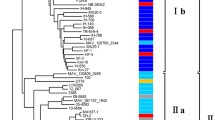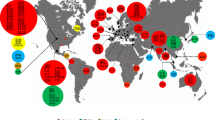Abstract
In this study, we epidemiologically investigated on clinical isolates of Arthroderma benhamiae from humans and animals in Japan by internal transcribed spacer (ITS) region sequence analysis and mating type (MAT)-specific PCR. Seven of 8 A. benhamiae isolates from a human, rabbits and guinea pigs were identified as group I (white phenotype) by morphological characters and ITS region sequence analysis. One strain isolated from a degus (Octodon degus) produced colonies with few irregular folds and yellow velvety mycelium without macro- and microconidia. This strain resembled to group II (yellow phenotype) strain. ITS sequence analysis was also 100 % identical to that of group II. MAT-specific PCR indicated that 6 of these 7 isolates of group I contained an alpha-box gene and that one strain contained high-mobility-group (HMG) gene. One strain of group II was revealed to have an alpha-box gene and no HMG gene. To our knowledge, it is the first A. benhamiae isolate of group II found in Japan. The A. benhamiae may be more widespread in worldwide than our surpassing what is common or usual or expected.
Similar content being viewed by others
Avoid common mistakes on your manuscript.
Introduction
Teleomorphs of the Trichophyton mentagrophytes complex are Arthroderma benhamiae, A. simii and A. vanbreuseghemii [1, 10, 17, 19, 20]. Hironaga and Watanabe reported in 1980 that T. mentagrophytes isolates from human and animals in Japan were identified as A. vanbreseghemii, and not as A. benhamiae [4]. In 1998, however, we reported the first isolation of A. benhamiae from a pet rabbit in Japan [6]. Subsequently, A. benhamiae was isolated from humans, rabbits, guinea pigs and hedgehogs in different areas of Japan [3, 7, 11, 15, 16], indicating that A. benhamiae was imported from foreign countries and then is prevailing in companion animals of Japan. A. benhamiae was divided into two races due to the phenotypic characteristics and mating behavior: American–European race and African race [19, 20]. In 2008, we reported three genotypes of A. benhamiae. Genotypes 1, 2 and 3 were correspondent to isolates of American–European race, to isolates of African race and to isolates from hedgehogs in Japan, respectively [7]. The genotype 3 is closed to African race than to American–European race by chitin synthase 1 (CHS1) and internal transcribed spacer (ITS) region sequences analysis [7].
After then, Symoens et al. [18] reported that American–European race was further divided into two groups: Group I included isolates with a white phenotype, while group II included isolates with a yellow phenotype. Many strains of the former group strain have been isolated in Japan [9, 18]. An isolate from a degu (Octodon degus; a pet rodent in Europe and Japan) be included in the group II is the object of this communication. To our knowledge, it is the first A. benhamiae isolate of group II found in Japan.
Materials and Methods
Strains
Clinical isolates of A. benhamiae in Japan are listed in Table 1. IHEM20161 (white phenotype) and IHEM23024 (yellow phenotype) were used as reference strains of group I and group II, respectively, in this study (Table 1).
Cultures
Isolates were sub-cultured on Sabouraud’s dextrose agar (SDA) and were then morphologically characterized as group I (white phenotype) or a group II (yellow phenotype) [18].
ITS Region Sequences of Isolates
The ITS sequence analysis were carried out according previous report [7]. The DNA sequences were compared using Clustal W multiple sequence alignment programs [21], and a phylogenetic tree was constructed by the TREEVIEW displaying phylogenies program [14]. Bootstrap analysis was performed on 1,000 random samples and analyzed by the Clustal W programs [2].
PCR Analysis of Alpha-Box and High-Mobility-Group (HMG) Genes
Genomic DNA samples were derived by previous report [8]. Primers TmMATa1S and TmMATa1R amplified a 471-bp fragment of the A. vanbreuseghemii alpha-box gene [5, 8]. Primers TmHMG1S and TmHMG1R amplified a 524-bp fragment of the A. vanbreuseghemii HMG [5, 8].
Genomic DNA samples (100 ng) from the clinical isolates were amplified by PCR in a volume of 30 μl, using a reaction mixture containing 10 mM Tris–HCl (pH 8.3), 50 mM KCl, 1.5 mM MgCl2, 0.001 % gelatin, 200 mM each deoxynucleoside triphosphate, 1.0 unit of Taq polymerase (Takara Bio) and 0.5 μg of a pair of primers. Amplification was carried out over 35 cycles consisting of template denaturation (1 min, 94 °C), primer annealing (1 min, 57 °C) and polymerization (2 min, 72 °C). PCR products were detected by electrophoresis on 2 % agarose gel followed by staining with ethidium bromide and visualization under UV light.
Results
Seven of 8 A. benhamiae isolates from a human, rabbits and guinea pigs were identified as strains of group I (white phenotype) similar to IHEM20161 by morphological characters of the cultures (Table 1) [18]. The ITS sequence of 6 of these 7 isolates was 100 % identical to sequence AB048192 deposited for KMU4136, which was isolated human skin in Japan and deposited by Kawasaki et al. [18]. These six strains contained an alpha-box gene. The ITS sequence of the 7th isolate (VUT97010) was 100 % identical to sequence AB048192. This isolate contained an HMG gene (Table 1).
One strain (NUBS13001) isolated from a degus (Octodon degus) produced colonies with few irregular folds (Fig. 1) and yellow velvety mycelium without macro- and microconidia. This strain resembled IHEM23024 of group II (yellow phenotype) strain [18]. Its ITS sequence was also 100 % identical to AB088677 deposited by Kawasaki for RV26680 reference strain (American–European race) and revealed in strain IHEM23024 of group II (Fig. 2) [18]. Like strains of group II, NUBS13001 was revealed to have an alpha-box gene and no HMG gene. The sequences determined in this study have been deposited in GenBank (Arthroderma benhamiae genes for ITS1, 5.8S rRNA, ITS2, 28S rRNA, partial sequences, strain: NUBS13001; DDBJ Accession Number: AB973435).
A tree shows phylogenetic relationships among the obtained ITS region sequences from dermatophytes. Numbers at branches were determined by bootstrap analysis, indicating the times in 1,000 repeat sub-samples in monophylogenic grouping. Parenthesis indicates the GenBank accession number of ITS region analysis of dermatophytes. Genotypes 1, 2 and 3 were reported in reference [7]. Group I and II were reported in reference [18]
Discussion
Arthroderma benhamiae is a zoophilic dermatophyte, which is causative highly inflammatory tinea corporis and tinea capitis on humans. In this study, we epidemiologically investigated molecular analysis on clinical isolates of A. benhamiae in Japan. Seven examined isolates were found to belong to the genotype I, corresponding to American–European race in our previous study [7]. Moreover, these were divided into two groups as reported by Symoens et al. [18]. A strain (NUBS13001) was confirmed to belong to the group II, attesting for the existence of strains of this group also in Japan.
NUBS13001 and IHEM23024 strains like other isolates of group II have only an alpha-box gene, indicating that they are of MAT (−) [8, 18]. Isolates of group II are pathogenic to human and animals, and it is assumed that genetic exchange (mating) in this group could not occur in nature [18]. On the other hand, the group I contains strains of either (−) or (+) mating type. Strain interfertitlity occurs in this group. Strains of MAT (−) appeared to be more frequent in Japan than in Europe [18]. Future study is needed to investigate the bias of MAT (−) in this group to prevent this zoonotic dermatophytosis.
The infections due to the A benhamiae are being more frequently diagnosed in Europe [12, 13]. The colony morphology of group II may be confused with M. canis, T. erinacei, and even T. soudanen-se [12, 13]. The group II may be more widespread than our surpassing what is common or usual or expected.
Arthroderma benhamiae was imported from foreign countries with companion animals and is now prevailing between animals and humans in Japan. Therefore, dermatologists that manage the dermatophytosis of pet owners should take care of the epidemiological state of this zoophilic dermatophyte species.
References
Ajello L, Cheng S-L. The perfect state of Trichophyton mentagrophytes. Sabouraudia. 1967;4:230–4.
Felsenstein J. Confidence limits on phylogenies: an approach using the bootstrap. Evolution. 1985;39:783–91.
Hata Y, Amagai M, Naka W, Harada R, Nishikawa T. Two cases of Trichophyton mentagrophytes infection contracted from a hamster and a chinchilla. Nihon Ishinkin Gakkai Zasshi. 2000;41:269–73.
Hironaga M, Watanabe S. Mating behavior of 334 Japanese isolates of Trichophyton mentagrophytes in relation to their ecological status. Mycologia. 1980;72:1159–70.
Hiruma J, Kano R, Kimura U, Takamori K, Suga Y, Hiruma M, Hasegawa A, Tsuboi R. Mating type gene for isolates of Trichophyton mentagrophytes from guinea pigs. J Dermatol. 2014;41:743–5.
Kano R, Nakamura Y, Yasuda K, Watari T, Watanabe S, Takahashi H, Tsujimoto H, Hasegawa A. The first isolation of Arthroderma benhamiae in Japan. Microbiol Immunol. 1998;42:575–8.
Kano R, Sano A, Makimura K, Watanabe S, Nishimura K, Yamaguchi H, Hasegawa A. A new genotype of Arthroderma benhamiae. Med Mycol. 2008;46:739–44.
Kano R, Kawasaki M, Mochizuki T, Hiruma M, Hasegawa A. Mating genes of the Trichophyton mentagrophytes complex. Mycopathologia. 2012;173:103–12.
Kawasaki M, Inoue T, Ohsawa T, Ishioka S, Mochizuki T, Ishizaki H. Two Arthroderma benhamiae isolates showing mitochondrial DNA type of Trichophyton verrucosum. Nihon Ishinkin Gakkai Zasshi. 2002;43:103–6.
Kwon-Chung KJ, Bennett EJ. Dermatophytoses: medical mycology. Philadelphia: Lea & Febiger; 1992. p. 130–2 pp. 816–826.
Mochizuki T, Kawasaki M, Ishizaki H, Kano R, Hasegawa A, Tosaki H, Fujihiro M. Molecular epidemiology of Arthroderma benhamiae, an emerging pathogen of dermatophytoses in Japan, by polymorphisms of the non-transcribed spacer region of the ribosomal DNA. J Dermatol Sci. 2001;27:14–20.
Nenoff P, Krüger C, Ginter-Hanselmayer G, Tietz HJ. Mycology—an update. Part 1: dermatomycoses: causative agents, epidemiology and pathogenesis. J Dtsch Dermatol Ges. 2014;12:188–209.
Nenoff P, Uhrlaß S, Krüger C, Erhard M, Hipler UC, Seyfarth F, Herrmann J, Wetzig T, Schroedl W, Gräser Y. Trichophyton species of Arthroderma benhamiae: a new infectious agent in dermatology. J Dtsch Dermatol Ges. 2014;12:571–81.
Page RDM. TREEVIEW: an application to display phylogenetic trees on personal computers. Comput Appl Biosci. 1996;12:357–8.
Saito K, Kano R, Nakamura, Watanabe S, Hasegawa A. Arthroderma benhamiae infection in a rabbit. J Vet Med Sci. 2001;63:929–31.
Shiraki Y, Hiruma M, Kano R, Miyamoto C, Ikeda S. Case of tinea capitis caused by Trichophyton mentagrophytes (molecular type Arthroderma benhamiae): prevalence of a new zoonotic fungal infection in Japan. J Dermatol. 2006;33:504–6.
Stockdale MP, Mackenzie WRD, Austwick KCP. Arthroderma simii sp. nov., the perfect state of Trichophyton simii (Pinoy) comb. nov. Sabouraudia. 1967;4:112–23.
Symoens F, Jousson O, Packeu A, Fratti M, Staib P, Mignon B, Monod M. The dermatophyte species Arthroderma benhamiae: intraspecies variability and mating behavior. J Med Microbiol. 2013;62:377–85.
Takashio M. Observations on African and European strains of Arthroderma benhamiae. Int J Dermatol. 1974;13:94–101.
Takashio M. The Trichophyton mentagrophytes complex. In: Iwata K, editor. Recent advances in medical and veterinary mycology. Tokyo: University of Tokyo Press; 1977. p. 271–6.
Thompson JD, Higgins DG, Gibson TJ, Gibson TJ. CLUSTAL W: improving the sensitivity of progressive multiple sequence alignment through sequence weighting, position-specific gap penalties and weight matrix choice. Nucl Acid Res. 1994;22:4673–80.
Acknowledgments
This study was partly funded by Health, Labor and Welfare Sciences Research Grants for Research on Measures for Intractable Diseases (H25 shinko-ippan 006) from the Japanese Government.
Conflict of interest
The authors have no conflict interest.
Author information
Authors and Affiliations
Corresponding author
Rights and permissions
About this article
Cite this article
Hiruma, J., Kano, R., Harada, K. et al. Occurrence of Arthroderma benhamiae Genotype in Japan. Mycopathologia 179, 219–223 (2015). https://doi.org/10.1007/s11046-014-9839-0
Received:
Accepted:
Published:
Issue Date:
DOI: https://doi.org/10.1007/s11046-014-9839-0






